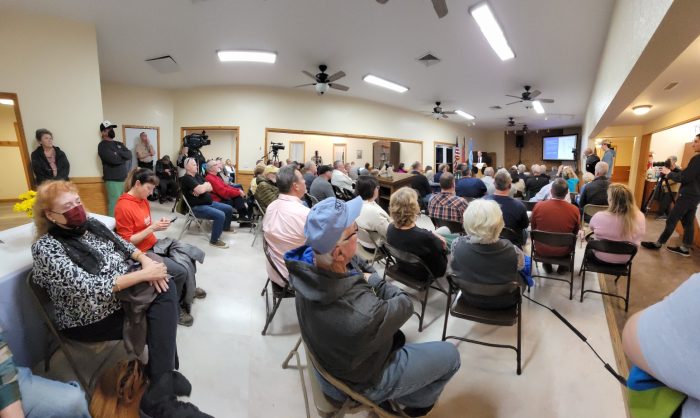
More than 100 in-person and 160 virtual attendees were present at a public meeting on Wednesday evening, January 18, that outlined the process and challenges of conducting a beach nourishment project in Rodanthe.
After a brief introduction by Dare County Board of Commissioners (BOC) Chairman Bob Woodard, County Manager Bobby Outten presented an overview of the logistics and funding models that made previous beach nourishment projects possible in the past, and explained why a Rodanthe project was more of a challenge.
Although 50 in-person attendees signed up to ask questions or speak in the public comment period following the presentation, the majority of questions were answered during Outten’s roughly 30-minute presentation.
Key points and explanations that stemmed from the presentation include the following:
How beach nourishment is funded
Dare County’s Beach Nourishment Fund is funded by a 2% portion of Dare County’s 6% Occupancy Tax. The 2% is restricted by state legislation to be used for the placement of sand from other sources for the purpose of widening the beach, in order to benefit public recreational use, and to mitigate damage and erosion from storms to inland property.
In addition to the Dare County’s Occupancy Tax, beach nourishment is also funded by various property and municipal service district taxes, as well as state and FEMA Public Assistance program funds, when applicable. For example, in Avon and Buxton, new tax districts were established so that residents in these villages could pay for approximately 50% of a beach nourishment project.
Beach nourishment is also not a one-time endeavor, and funds need to be secured for maintenance or replenishing projects, which occur every five years.
What’s being done toward a potential Rodanthe beach nourishment project
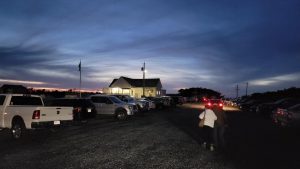
The BOC approved taking steps toward a new Feasibility Study to determine the precise costs of performing a beach nourishment project in Rodanthe at their January 3 meeting in Manteo.
The last time that a study was conducted was in 2013, and this new study will be performed in approximately two months.
The study is an initial step in any Dare County beach nourishment project, but it does not guarantee that a nourishment project will occur. Instead, it will give the county an exact estimate of the costs involved, and will help with future decisions, if and when funds are available for additional projects.
“We need an updated look at the erosion rates,” said Outten in an earlier interview, noting that while the county’s beach nourishment projects tend to cost around $10 million per mile, a Rodanthe project would likely be more expensive. “The issue we have there is that the erosion rates are accelerated, so those costs are going to be more.”
The logistics and challenges of a Rodanthe beach nourishment project
While an exact cost of a Rodanthe project was not available for Wednesday’s public meeting, Outten outlined the challenges of a Rodanthe project based on a section of Rodanthe shoreline that was 2.25-miles long, and which would cost approximately $30 million to nourish.
In order to receive permission from the U.S. Department of the Interior to conduct a beach nourishment project, a project must benefit public infrastructure, and not just private property. (In Avon and Buxton, the projects were conducted to protect N.C. Highway 12, which flooded on a routine basis and became impassable during minor or moderate storms.) Outten stated that this obstacle could be overcome for a Rodanthe project, due to the RWS Water Treatment Plant near Midgett Drive.
The main issue with greenlighting a Rodanthe project is priority and funding.
“We have about $6 million available to us [in the county’s beach nourishment fund] to put into a project somewhere,” said Outten at the meeting. “If [the fund] is growing at 3% or 4% a year, it’s growing at less than half a million dollars a year, so that’s 60 years for the fund to grow to get [the $30 million], assuming you could hold today’s cost and do it 60 years from now. So that fund is not going to fund beach nourishment anywhere in the county, and not in Rodanthe.”
“So, the question becomes, could we tax the people in Rodanthe enough to make up that money?”
As Outten outlined at the meeting, even if a special tax district was created for every oceanside and soundside property in Rodanthe, (similar to the 2022 Avon project), the contribution would not be significant due to the small number of property owners.
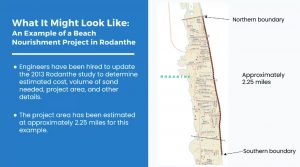
“The tax base in Rodanthe is so small that it really won’t generate a significant amount of the costs – maybe a million dollars or less for what would be a $25 million or $30 million project,” said Outten in an earlier interview.
Outten did note that the BOC, as well as other county and state representatives, were reaching out to connections within federal and state governments to generate a new source of funds for beach nourishment projects.
“I’ve talked with [National Parks of Eastern North Carolina Superintendent] Dave Hallac, and he’s gotten some requests into the Park Service that could help us. The issue there is that he’s competing for funds for beach nourishment against funds for every other park in the United States at some level or another, and we really don’t know how that prioritization is going to occur at the Department of Interior.”
He also noted that the state could provide another route for funding.
“We’ve been working with the [state] legislature for a while to try to get them to create a beach nourishment fund, not just for our county but for the whole state, like they did an ‘inlet management fund’ when they created dredge money for all the shallow draft inlets throughout the state. We need a recurring fund at the state level to help fund nourishment projects throughout North Carolina,” said Outten. “We haven’t been to Raleigh in the last five or six years where haven’t had a conversation with our legislative delegation about that… [and] they led us to believe they’re in favor of trying to do it.”
“So where are we now? The county doesn’t have funds to pay for a beach nourishment project. We don’t have $30 million to do that. And without an influx of new money, we aren’t going to be in a position to nourish in Rodanthe.”
“That’s the first problem…. Then the question is, when you have money, what is your priority?”
Rodanthe is not the only community on Hatteras Island that is in need of a beach nourishment project or another fix to keep erosion at bay.
The section of N.C. Highway 12 just north of Hatteras village, (known locally as “Isabel’s Inlet” due to the temporary inlet that formed after 2003’s Hurricane Isabel), floods with ocean overwash regularly after storms. In addition, the Canal Zone on northern Pea Island is also subject to regular storm-related oceanside flooding, resulting in road closures.
Meanwhile, since the opening of the Jug Handle Bridge in July 2022, N.C. Highway 12 in Rodanthe has not closed due to ocean flooding during the last few minor or moderate storms, although the old section of the highway in the Mirlo Beach area, (which the bridge now bypasses), flooded regularly.
“All of those places are at risk,” said Outten. “And so, the question becomes when you have the money, what is your priority?”
“What we would like to have happen is we would like the Department of Transportation (DOT) to take responsibility for the area in the Canal Zone… and Isabel’s Inlet, so that relieves us of that burden,” said Outten. “If that were to occur, then we can focus our efforts on our third spot, and that’s the area in Rodanthe.”
Outten noted that, historically, DOT has been reactive to these challenges, fixing inlets and breeches when they occur, due to limited funding. So, if the county has to address all three hotspots, there needs to be a determination of which hotspot should be addressed first.
“It becomes really difficult if DOT doesn’t take the responsibility for the road and leaves us [to conduct projects] like they did in Buxton, and like they did in Avon,” said Outten, noting that when Isabel’s Inlet floods, all access to Hatteras village is cut off, and when the Canal Zone floods, all access to Hatteras Island is cut off.
“And the question becomes, if we’re required to have that responsibility, is [Rodanthe] a higher priority? Those are hard decisions, tough decisions, that have to be made when and if funding becomes available.”
Public questions and answers
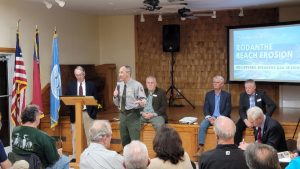
After the presentation, Outten fielded a number of questions from virtual and online attendees, although many folks withdrew their questions as they were already addressed in the presentation.
Questions that were asked at the Wednesday night meeting include the following:
Has Dare County considered other options—such as the installation of terminal groins, jetties, or seawalls—to address the issue of shoreline erosion?
In 2003, the North Carolina General Assembly voted unanimously to formally adopt a law banning hard structures, such as seawalls and terminal groins. This law bans the construction of new, permanent erosion-control structures on beaches within the state.
Other options that aren’t hard structures—such as geotubes and offshore reefs—are not approved for use in North Carolina.
Therefore, beach nourishment is currently the only tool that Dare County has available to protect infrastructure from beach erosion and subsequent flooding and overwash.
Has Dare County considered increasing the 6% occupancy tax to generate more funds for beach nourishment?
“The occupancy tax is a creature of the legislation. It gives us the authority to impose a tax on the visitors that rent dwellings and rent hotel rooms and occupied rental space in the county, and they’ve given that authority to all 100 counties, and have put a cap on that up to 6%,” said Outten. “So, if we go and ask for an extra penny for occupancy tax, Mecklenburg [county] then goes and asks for a penny for schools, Wake asks for a penny for a Greenway or sidewalks or transportation, and on and on and on.”
“And all of a sudden, you’ve got now a seven-cent statewide occupancy tax, which the tourism lobby is adamantly opposed to,” he added. “They have a lot of influence in the legislature, and the legislature is going to do that.”
Can we cut an inlet north of Rodanthe?
Outten explained that creating a manmade inlet would be a huge undertaking with a lengthy permit process, and that creating an inlet would not necessarily solve the erosion problem. In other Outer Banks inlets, including Oregon Inlet and Hatteras Inlet, the terrain on the south side of the inlet tends to erode, which would create more erosion problems instead of alleviating them.
What plans does Dare County have to deal with erosion on the soundside of Hatteras Island?
Currently, there is no plan in place because private property owners on the soundside have opportunities to do things to protect their property that homeowners on the oceanside do not. (For example, on the soundside, property owners can construct a bulkhead to protect their home.) “If we’re going to subsidize something, we need to do it in the places where people can’t help themselves,” said Outten. “And for us, that is the oceanfront, and not the soundside.”
Are there any funds available for sandbags and other short-term solutions?
No, as these projects are the homeowner’s responsibility.
Is Rodanthe eligible for beach nourishment, considering that beach nourishment projects are only permitted if there’s a threat to community infrastructure, and not just private property?
Yes. Beach nourishment projects are only allowed by the U.S. Department of the Interior if erosion is affecting public infrastructure. (For Avon and Buxton, beach nourishment projects were conducted to protect N.C. Highway 12.) In Rodanthe, a beach nourishment project could be conducted in order to protect the community’s water treatment plant.
The meeting lasted approximately two hours, which included roughly an hour of Q&A. To watch the meeting in its entirety, visit the Dare County YouTube channel.
For more information on beach nourishment, visit the Dare County’s FAQs page.



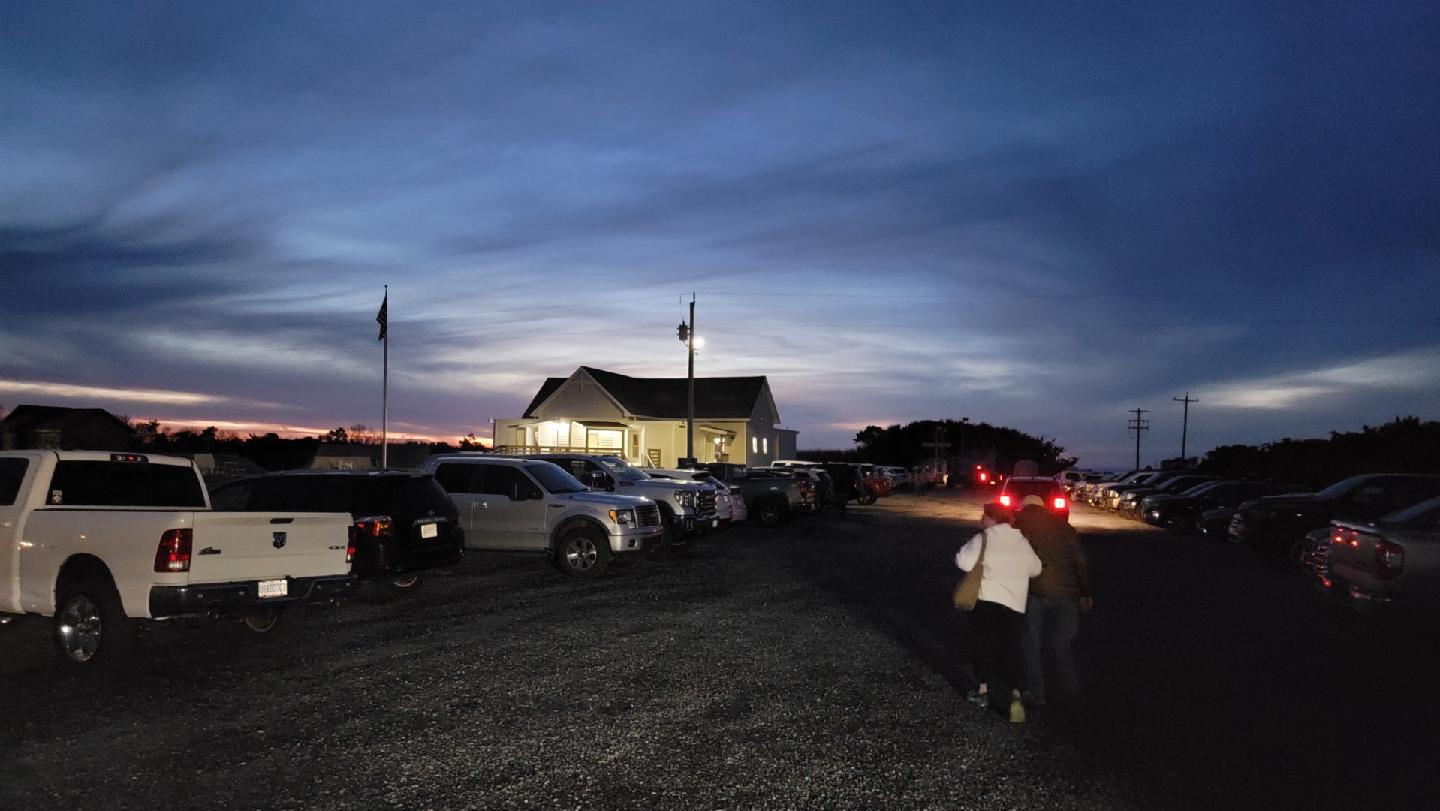






FACT: THE AVON PROJECT WASHED AWAY IN 2 MONTHS.. WASTED 30 MILLION..!!??